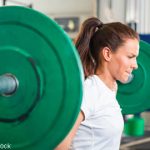SAN FRANCISCO—It’s healthy—physically and socially—for children and adolescents to participate in sports. But engaging in athletic pursuits also can entail risks, especially for developing young bodies.
Physicians have a window of opportunity to make a difference in the future health and quality of life of young female athletes, emphasized Aurelia Nattiv, MD, a professor in the UCLA department of family medicine, and division of sports medicine in the department of orthopedics at UCLA. Dr. Nattiv, the first of three presenters at the October 2008 ACR/ARHP Annual Scientific Meeting presentation, “Treating the Young Athlete,” served as chair of the American College of Sports Medicine’s Revised Position Stand on the Female Athlete Triad.1 In her presentation, Dr. Nattiv outlined the current science underpinning the revised position stand, and also touched on common musculoskeletal injuries seen in female athletes.
The female athlete triad is currently defined as energy availability, menstrual function, and bone strength, three interrelated items that exist on continuums from health to disease, Dr. Nattiv explained. She noted that “energy availability” has replaced the term “eating disorder,” and is defined as the amount of dietary energy remaining for all other physiological functions after energy has been expended in exercise.
While clinicians may be more familiar with the frank clinical manifestations of the triad (e.g., eating disorders, functional hypothalamic amenorrhea, and osteoporosis), Dr. Nattiv said, “A large group of female athletes don’t have an eating disorder [and therefore do not fall within the DSM-IV eating disorder diagnoses]. But, these athletes still need education about meeting their energy needs.” Negative energy availability is now considered key to the triggering of pathologic processes. For example, recent research is showing that reduced energy availability is a co-risk factor for lowered bone density, along with menstrual dysfunction.
Building bone density is of crucial importance between ages 10 and 14, with 90% of peak bone mass being reached at around age 18. “It’s hard to gain bone back,” Dr. Nattiv reminded her audience, and showed slides of severe osteoporosis in young women. She urged session participants to be proactive and screen all girls and women in sports and regular exercise programs for the triad disorders. This screening should include a menstrual history and nutritional habits, among other elements. A baseline bone density may be indicated if a girl has experienced prolonged amenorrhea or oligomenorrhea for over six to 12 months and has a lower body weight and/or pathologic stress fractures. Because building bone in younger women does not respond to boosting estrogen with oral contraceptives (a different mechanism is at work than in postmenopausal bone mineral loss), Dr. Nattiv argues for a nutritionally based approach to boost body weight while ensuring adequate vitamin C and D intake.
Think Apophysitis, Not Tendonitis
Next, Sally S. Harris, MD, MPH, a clinical instructor of pediatrics at Stanford University School of Medicine and a pediatric sports medicine specialist at Palo Alto Medical Foundation in Portola Valley, CA, described a series of common overuse injuries, which can mimic rheumatologic conditions. Because they develop insidiously and tend to be chronic, overuse injuries may be referred to the rheumatologist for diagnosis. In these situations, it’s important to understand the structure of the immature skeleton so that patients can be properly referred and treated, noted Dr. Harris. For example, she cautioned: “Beware of the diagnosis of tendonitis,” because it is rare in children. “By definition,” she explained, “tendonitis refers to degenerative changes, and tissues of kids and adolescents are too healthy to exhibit such changes—although they can be seen in rare cases.”

